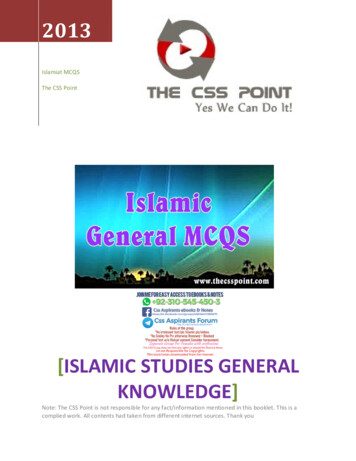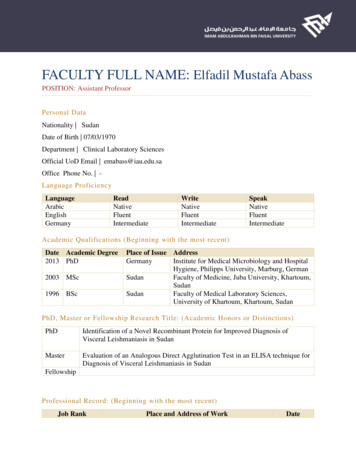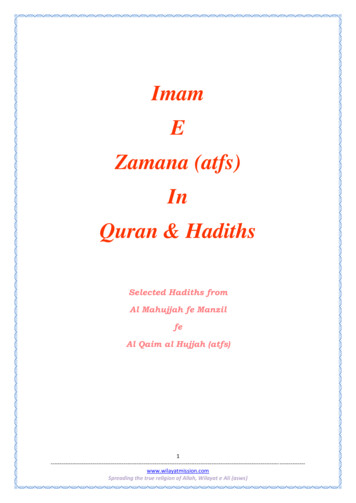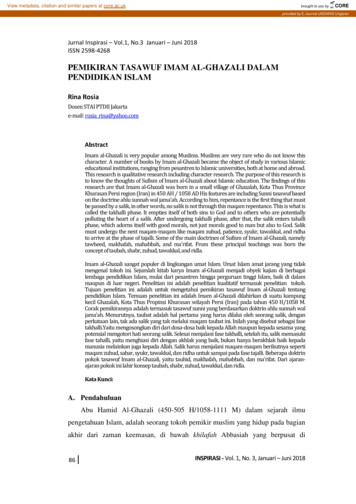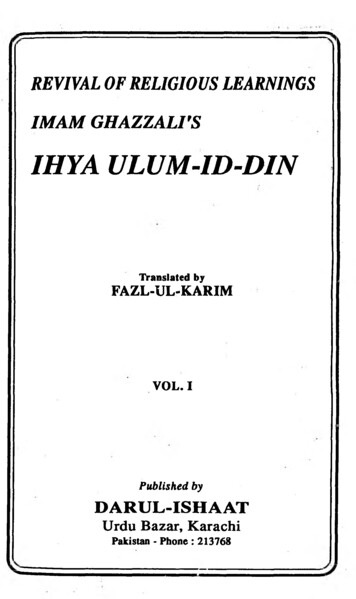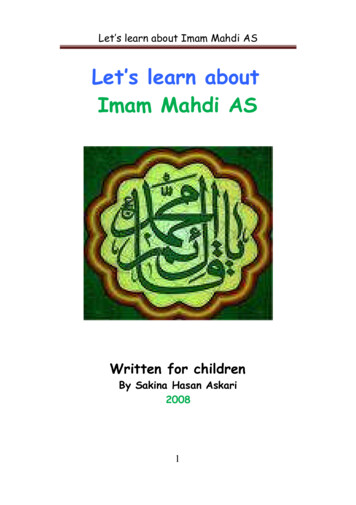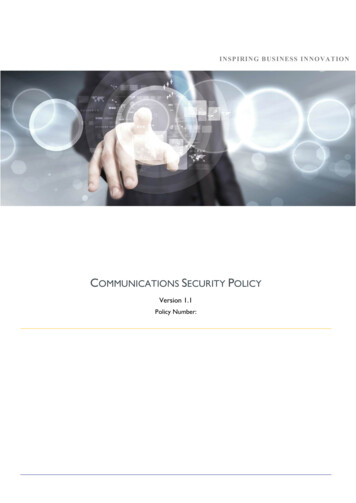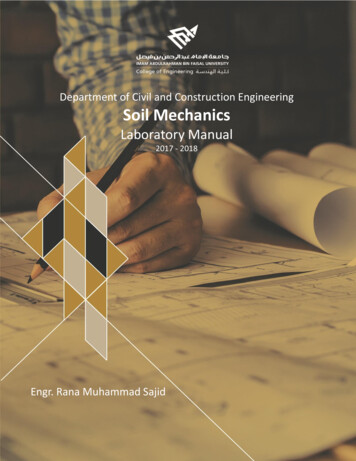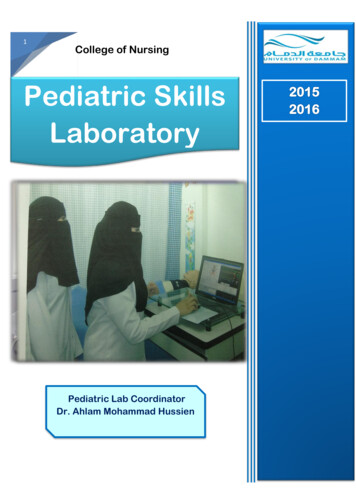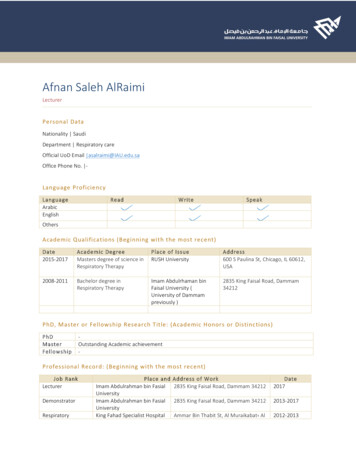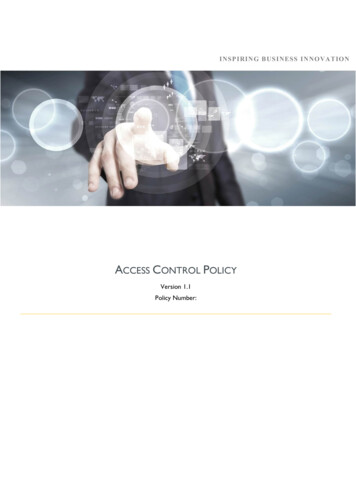
Transcription
INSPIRING BUSINESS INNOVATIONACCESS CONTROL POLICYVersion 1.1Policy Number:
ACCESS CONTROL POLICY1. Table of Contents1. Table of Contents . 22. Property Information . 33. Document Control . 43.1. Information. 43.2. Revision History . 43.3. Review, Verification and Approval . 43.4. Distribution List . 44. Policy Overview . 54.1. Purpose . 54.2. Scope. 54.3. Terms and Definitions . 54.4. Change, Review and Update . 74.5. Enforcement / Compliance . 74.6. Waiver. 74.7. Roles and Responsibilities (RACI Matrix) . 84.8. Relevant Documents . 84.9. Ownership . 95. Policy Statements . 105.1. Access Control Policy. 105.2. Access to Networks and Network Services . 115.3. User Registration and De-Registration. 135.4. User Access Provisioning . 145.5. Management of Privileged Access Rights . 155.6. Management of Secret Authentication Information of Users . 155.7. Review of User Access Rights . 165.8. Removal or Adjustment of Access Rights . 175.9. Use of Secret Authentication Information . 175.10. Information Access Restriction. 185.11. Secure Log-On Procedures . 195.12. Password Management System . 195.13. Use of Privileged Utility Programs . 205.14. Access Control to Program Source Code . 20Page 2/19
ACCESS CONTROL POLICY2. Property InformationThis document is the property information of Imam Abdulrahman bin Faisal University - ICT Deanship. Thecontent of this document is Confidential and intended only for the valid recipients. This document is notto be distributed, disclosed, published or copied without ICT Deanship written permission.Page 3/19
ACCESS CONTROL POLICY3. Document Control3.1. InformationTitleClassificationVersionStatusACCESS CONTROL POLICYConfidential1.0validated3.2. Revision HistoryVersionAuthor(s)Issue DateChanges0.1Alaa Alaiwah - DevoteamNovember 17, 2014Creation0.2Nabeel Albahbooh - DevoteamNovember 27, 2014Update0.3Osama Al Omari – DevoteamDecember 23, 2014QA1.0Nabeel Albahbooh – DevoteamDecember 31, 2014Update1.1Muneeb Ahmad – ICT, IAU21 April 2017Update3.3. Review, Verification and ApprovalNameLamia Abdullah AljafariDr. Saad Al-AmriTitleDateQuality DirectorDean of ICT3.4. Distribution ListCopy #RecipientsLocationPage 4/19
ACCESS CONTROL POLICY4. Policy OverviewThis section describes and details the purpose, scope, terms and definitions, change, review and update,enforcement / compliance, wavier, roles and responsibilities, relevant documents and ownership.4.1. PurposeThe main purpose of Access Control Policy is to:Limit access to information and information processing facilities, ensure authorized user access and to preventunauthorized access to systems and services, make users accountable for safeguarding their authenticationinformation, and prevent unauthorized access to systems and applications.4.2. ScopeThe policy statements written in this document are applicable to all IAU’s resources at all levels of sensitivity;including: All full-time, part-time and temporary staff employed by, or working for or on behalf of IAU. Students studying at IAU. Contractors and consultants working for or on behalf of IAU. All other individuals and groups who have been granted access to IAU’s ICT systems andinformation.This policy covers all information assets defined in the Risk Assessment Scope Document and will be used as afoundation for information security management.4.3. Terms and DefinitionsTable 1 provides definitions of the common terms used in this document.TermAccountabilityDefinitionA security principle indicating that individuals shall be able to be identifiedand to be held responsible for their actions.Page 5/19
ACCESS CONTROL lineInformation that has value to the organization such as forms, media,networks, hardware, software and information system.The state of an asset or a service of being accessible and usable upondemand by an authorized entity.An asset or a service is not made available or disclosed to unauthorizedindividuals, entities or processes.A means of managing risk, including policies, procedures, and guidelineswhich can be of administrative, technical, management or legal nature.A description that clarifies what shall be done and how, to achieve theobjectives set out in policies.A user is only granted access to the information he needs to perform hisNeed to Knowtasks (different tasks/roles mean different need-to-know and hencedifferent access profiles).Need to UseA user is only granted access to IT facilities (e.g., equipment, applications,procedures and rooms) he needs to perform hi task/job/role.The preservation of confidentiality, integrity, and availability ofInformation Securityinformation. Additionally, other properties such as authenticity,accountability, non-repudiation and reliability can also be involved.IntegrityMaintaining and assuring the accuracy and consistency of asset over itsentire life-cycle.A person or group of people who have been identified by ManagementOwneras having responsibility for the maintenance of the confidentiality,availability and integrity of an asset. The Owner may change during thelifecycle of the asset.A plan of action to guide decisions and actions. The policy processPolicyincludes the identification of different alternatives such as programs orspending priorities, and choosing among them on the basis of the impactthey will have.ProvisioningRiskA process of assigning or revoking access rights for users to information,systems and services.A combination of the consequences of an event (including changes incircumstances) and the associated likelihood of occurrence.An equipment or interconnected system or subsystems of equipmentSystemthat is used in the acquisition, storage, manipulation, management,control, display, switching, interchange, transmission or reception of dataPage 6/19
ACCESS CONTROL POLICYand that includes computer software, firmware and hardware.Table 1: Terms and Definitions4.4. Change, Review and UpdateThis policy shall be reviewed once every year unless the owner considers an earlier review necessary toensure that the policy remains current. Changes of this policy shall be exclusively performed by theInformation Security Officer and approved by Management. A change log shall be kept current and be updatedas soon as any change has been made.4.5. Enforcement / ComplianceCompliance with this policy is mandatory and it is to be reviewed periodically by the Information SecurityOfficer. All IAU units (Deanship, Department, College, Section and Center) shallensure continuouscompliance monitoring within their area.In case of ignoring or infringing the information security directives, IAU’s environment could be harmed (e.g.,loss of trust and reputation, operational disruptions or legal violations), and the fallible persons will be maderesponsible resulting in disciplinary or corrective actions (e.g., dismissal) and could face legal investigations.A correct and fair treatment of employees who are under suspicion of violating security directives (e.g.,disciplinary action) has to be ensured. For the treatment of policy violations, Management and HumanResources Department have to be informed and deal with the handling of policy violations.4.6. WaiverInformation security shall consider exceptions on an individual basis. For an exception to be approved, abusiness case outlining the logic behind the request shall accompany the request. Exceptions to the policycompliance requirement shall be authorized by the Information Security Officer and approved by the ICTDeanship. Each waiver request shall include justification and benefits attributed to the waiver.The policy waiver period has maximum period of 4 months, and shall be reassessed and re-approved, ifnecessary for maximum three consecutive terms. No policy shall be provided waiver for more than threeconsecutive terms.Page 7/19
ACCESS CONTROL POLICY4.7. Roles and Responsibilities (RACI Matrix)Table 22 shows the RACI matrix1 that identifies who is responsible, accountable, consulted or informed forevery task that needs to be performed. There are a couple of roles involved in this policy respectively: ICTDeanship, Information Security Officer (ISO), Human Resources Department / Administrative Unit (HR/A),Owner and User (Employees, Faculty Members, Students, Contractors, Consultants and Third Parties).RolesResponsibilitiesDetermining the required access rights of users to assets.Adhering to information security policies and procedurespertaining to the protection of information.Reporting actual or suspected security incidents to ICTDeanshipEnsuring resigned or terminated employee return all IAU’sassets interested before they complete terminationprocess.Revoking access rights (logical and physical) to assets uponemployee termination or change.Ensuring the protection of information / infrastructuresystems, according to the technological mechanisms definedby the system / application design team.Investigating breaches of security controls, andimplementing additional compensating controls whennecessary.Implementing proper controls to protect assets.Reviewing user access rights and privileges in a regular basis.Approving user access registration Table 2: Assigned Roles and Responsibilities based on RACI Matrix4.8. Relevant DocumentsThe followings are all relevant policies and procedures to this policy: Information Security Policy Human Resource Security Policy1The responsibility assignment RACI matrix describes the participation by various roles in completing tasks for a business process. It isespecially useful in clarifying roles and responsibilities in cross-functional/departmental processes. R stands for Responsible who performsa task, A stands for Accountable (or Approver) who sings off (approves) on a task that a responsible performs, C stands for Consulted(or Consul) who provide opinions, and I stands for Informed who is kept up-to-date on task progress.Page 8/19
ACCESS CONTROL POLICY Physical and Environmental Security Policy Operations Security Policy Communications Security Policy Compliance Policy Risk Management Policy Change Management Procedure Physical and Logical Access Control Procedure Human Resource Security Procedure4.9. OwnershipThis document is owned and maintained by the ICT Deanship of University of Imam Abdulrahman bin Faisal.Page 9/19
ACCESS CONTROL POLICY5. Policy StatementsThe following subsections present the policy statements in 14 main aspects: Access Control Policy Access to Networks and Network Services User Registration and De-Registration User Access Provisioning Management of Privileged Access Rights Management of Secret Authentication Information of Users Review of User Access Rights Removal of Adjustment of Access Rights Use of Secret Authentication Information Information Access Restriction Secure Log-On Procedures Password Management System Use of Privileged Utility Programs Access Control to Program Source Code5.1. Access Control Policy1. Access to information shall be controlled based on business and security requirements and the accesscontrol rules defined for each IAU’s system. These rules shall include the followings:a. Both logical and physical access controls.b. Security requirements of IAU’s business applications.c. An identified business requirement for the user to have access to the information or businessprocess (both ‘need-to-know’ and ‘need-to-use’ principles).d. All access is denied unless specifically approved under the provisions of this policy.Page 10/19
ACCESS CONTROL POLICYe. Changes in user permission whether performed automatically or by an administrator.f.Legal and/or contractual obligation to restrict and protect access to IAU’s systems.2. Access for contractors or third parties personnel to IAU’s business information assets shall beprovided only based on a contractual agreement. This agreement shall include, but not be limited to:a. The terms and conditions for access provided.b. The security responsibilities of the contractors or third parties personnel.c. Agreement by the contractors or third parties personnel to abide to IAU’s informationsecurity policies.Ref# [ISO/IEC 27001: A.9.1.1]5.2. Access to Networks and Network Services1. Access to networks and network services shall be authorized and controlled based on business,security requirements and access control rules defined for each network. These rules shall takeinclude the followings:a. Security requirements of the network or network services.b. An identified business requirement for the user to have access to the network (e.g., use ofVPN or wireless network) or network services (‘need-to-have’ principle).c. The user’s security classification and the security classification of the network.d. The user’s authentication requirements for accessing various network services.e. Monitoring and managing of the use of network services.f.The authorization mechanisms for determining who is allowed to access which networks andnetwork services.2. All computers shall be not connected to IAU network and be allowed full access to all networkresources and the Internet unless they fulfil with the network access control requirements as follows:a. Security policies of operating system.b. Updated antivirus definitions.c. Firewall security rules.Page 11/19
ACCESS CONTROL POLICY3. Access to IAU wired and wireless network shall be provided for employees, students and guests asper the following security requirements:Security RequirementsGroupWired NetworkWireless Network Checkforantivirusagent to check for an antivirus updateSymantecnot older than 5 days.endpoint, Antispyware and Antivirusdefinitions for an update not older than Employees Compliant users shall be granting access5 days.to UC services using their mobile devicesCompliant machines shall get fullafter profiling.access to IAU network based on the Web redirection to Cisco Web NAC Compliant users shall be granting aPort VLAN membership.limitedNon-compliant domain machines andconnection without accessing internalusers shall be denied to access the IAUnetwork resources.network (i.e., network resources and Internet access).accesstoonlyInternetNon-compliant users shall be totallyblockedfromaccessingnetworkresources (including Internet access). CheckforantivirusSymantecStudentsagent to check for an antivirus updatedefinitions for an update not older thannot older than 5 days. Compliant machines shall be granting alimited access to only SIS servers andInternet connection. Web redirection to Cisco Web NACendpoint, Antispyware and Antivirus5 days. Compliant users shall be granting accessto Internet and internal SIS servers. Non-compliant users shall be totallyblockedNon-compliant domain machines andfromaccessingnetworkresources (including Internet access).users shall be blocked from accessingSIS servers (i.e., SIS resources andInternet access).GuestsNo access at all Guest shall login to Open SSID foraccessing wireless connection.Page 12/19
ACCESS CONTROL POLICY Enforce redirect to web page to submitrequired information. AllowedforSelf-registrationbysubmitting First Name, Last Name andMobile Number. Users shall be receiving a valid One TimePassword (OTP) through SMS (i.e., loginwith credentials sent by SMS and mappedto Active Directory). Compliant users shall be granting alimited access to Internet only.Caption , and reference that this came from IAU4. Access to shared folders shall consider the followings:a. Only authorized for specific employees.b. Only used for IAU’s business purpose.c. Sharing any non-related business materials (e.g., photos, videos, audio files, etc.) shall not bepermitted.Ref:[ISO/IEC 27001: A.9.1.2]5.3. User Registration and De-Registration1. ICT Deanship shall define a formal access control procedure that includes clear steps in relation torequesting, creating, modifying, suspending and revoking user accounts.2. The granting of user access, changes to existing user access rights and removal of user access shallbe authorized by Owner taking into account the following:a. Least privilege (‘need-to-know’ principle).b. Segregation of duties.c. Level of access required.3. The process for managing user IDs shall address the following:Page 13/19
ACCESS CONTROL POLICYa. All IAU’s employees shall be identified with a unique ID that establishes identity. User IDshall require at least one factor of authentication (e.g., password, token number or biometricdevices).b. All IAU’s employees shall be registered by IAU’s formal approved user registrationprocedure.c. Redundant, shared or group user IDs shall not be allowed.d. Redundant user shall be removed or disabled.e. The number of privileged user IDs shall be strictly limited to those individuals who shall havesuch privileges for authorized business purposes.f.Multi-user systems administrators shall have at least two user-IDs to separate their privilegedaccess from their ordinary day-to-day access.g. Consistent access control across different types of IAU’s systems shall be achieved bysupporting standard user ID codes, production programs and file names, and system names.[ISO/IEC 27001: A.9.2.1]5.4. User Access Provisioning1. All authorized user accessing IAU’s assets shall be defined and documented. Authorizations processshall be tracked and logged as follows:a. Date of authorization.b. Identification of individual approving access.c. Description of access privileges granted.d. Description of why access privileges granted.2. The provisioning process for assigning or revoking access rights for users shall consider thefollowings:a. Obtaining a proper authorization from the system or service’s owner.b. Segregation of duties to ensure a proper access level is given.c. Access rights are not activated until an authorization process is completed.d. Records reflecting all user access rights are centrally kept up-to-date.Page 14/19
ACCESS CONTROL POLICYe. Updating users access rights based on IAU’s employees roles and responsibilities.f.Reviewing users access rights in a regular basis3. ICT Deanship shall grant users access to IAU’s systems and services in accordance with their businessrole and job description (i.e., access right profiles).[ISO/IEC 27001: A.9.2.2]5.5. Management of Privileged Access Rights1. The allocation and use of privileges access rights shall be managed as follows:a. Identification of access rights required for each system or process (e.g., operation system,database, application and network).b. Granting access rights based on a need-to-use and event-by-event principles.c. Defining expiry requirements for all access rights.d. Providing access rights in accordance with system’s configuration capabilities.2. Users shall not have access to administration account or privileges on their local machines.[ISO/IEC 27001: A.9.2.3]5.6. Management of Secret Authentication Information ofUsers1. All IAU’s systems shall require identification and authentication through a proper secretauthentication information method (e.g., passwords, token IDs, smart cards or biometrics).2. Prior to allowing user access to any IAU’s system or application, a password authentication methodshall be implemented as follows:a. Password shall be a minimum of 8 characters length for normal users and 12 characters forIT administrators (e.g., system admin, application admin, DB admin and network admin).b. Password shall be combination of at least three of the four followings: At least one lower case alphabetic character (a-z) At least one upper case alphabetic character (A-Z)Page 15/19
ACCESS CONTROL POLICY At least one number (0-9) At least one special character (e.g., @# % &*() - \ {}[]:";' /)c. Passwords shall not contain user ID.d. Passwords shall contain no more than two identical characters in a row and not made up ofall numeric or alpha characters.e. Blank password shall not be allowed.f.Users shall be required to change their password immediately after their first login to anysystem (i.e., It shall be configured to prompt a user to choose another password beforecontinuing with his session).g. User account shall be locked fort 3 minutes after 3 unsuccessful attempts:h. Password change shall be enforced (by the operating system or the application) at least every90 days. Re-use of the same password shall not be allowed.i.Initial password shall be only used one time (i.e., it shall be valid only for the involved user’sfirst login) and shall be expired at 23:59:59 of the date issued.j.Password shall be stored and transmitted in protected (e.g., encrypted or hashed) form, ifpossible.3. Passwords shall be immediately changed if there is any suspicion of password compromise; and thisshall be reported immediately to ICT Deanship.4. ICT Deanship shall change all IAU’s systems and software default usernames and passwords uponinstallation.5. ICT Deanship shall reset user passwords after getting a formal verification of user identity.REF: [ISO/IEC 27001: A.9.2.4]5.7. Review of User Access Rights1. Upon detection of any misconduct of privileged access rights, ICT Deanship shall restrict suchprivileges.2. All IAU’s users’ access rights shall be reviewed in accordance with the formally approved UserPhysical and Local Access Control Procedure.Page 16/19
ACCESS CONTROL POLICY3. ICT Deanship in cooperation with Asset Owner and Information Security Officer shall:a. Establish a user access rights review plan that includes: IAU’s systems to be reviewed. The review frequency.b. Review the following access privileges: Access profiles for high risk systems (mission critical systems) every three months Access profiles for medium risk systems every six months. Access profiles for normal risk systems on an annual basis.REF:[ISO/IEC 27001: A.9.2.5]5.8. Removal or Adjustment of Access Rights1. Department Manager shall promptly report all significant changes in employees’ duties and/oremployment status to Human Resources Department / Administration Unit and ICT Deanship.2. When an employee permanently leaves IAU:a. System administrators shall be notified.b. All IAU’s access privileges shall be promptly terminated.c. ICT Deanship, unless notified to the contrary, shall purge all files held in the employee’sdirectory one month after employment termination.[ISO/IEC 27001: A.9.2.6]5.9. Use of Secret Authentication Information1. Users shall be accountable for any activity associated with their access rights.2. Users shall not capture or otherwise obtain passwords, decryption keys or any other secretauthentication method that could permit unauthorized access.3. Users shall not do the following:a. Reveal a password over the phone to anyone.Page 17/19
ACCESS CONTROL POLICYb. Reveal a password in an email message.c. Reveal or distribute a password to others even to ICT Administrators or his boss.d. Talk about a password in front of other.e. Hint at the format of a password: Name of family, friends and co-workers Birthday, address and phone number Patterns: “aaabbb” and “1112222”f.Reveal a password on questionnaires or security forms.g. Share a password with family members.h. Reveal a password to co-workers while on vacation.i.Write a password on a piece of paper and left in a place where unauthorized users are ableto discover them.4. ICT Deanship shall ensure that:a. Passwords are always encrypted when held in storage or in system logs on any IAU’s system.b. Passwords are not be stored in internet browsers (i.e., cookie on user’s workstations arenot set for automatic password completion and login).c. Systems are designed, tested and controlled to prevent the retrieval of and the unauthorizeduse of stored passwords.REF: [ISO/IEC 27001: A.9.3.1]5.10. Information Access Restriction1. Appropriate controls shall be defined to control application systems functions as follows:a. Limiting outputs information.b. Restricting access to information based on a user access profile.c. Defining proper access privileges required (e.g., read, write, delete and execute).d. Implementing logical and physical access isolation between different critical IAU’s systems.Page 18/19
ACCESS CONTROL POLICY[ISO/IEC 27001: A.9.4.1]5.11. Secure Log-On Procedures1. Login into IAU’s operating systems shall be based on a formal secure logon procedure.2. All systems shall display a general notice warning message that access to IAU’s systems is granted toauthorized users only.3. The logon process on any system shall display only the limited information about the system and itspurposed use.4. When strong authentication and identification is required, authentication methods other thanpasswords (e.g., token IDs, smart cards or biometrics) shall be implemented.5. All systems shall limit the number of unsuccessful logon attempts allowed; the following shall beconsidered:a. Recording both successful and unsuccessful attempts.b. Forcing a time delay before further logon attempts are allowed or rejecting any furtherattempts without specific authorization.c. Sending an alarm message to the system console if the maximum number of logon attemptsis reached.6. ICT Administrators (e.g., system admin, application admin, DB admin and network admin) shall reviewall unsuccessful log attempts in a periodically basis.[ISO/IEC 27001: A.9.4.2]5.12. Password Management System1. ICT Deanship shall adopt an interactive system for managing passwords in order to:a. Enforce a quality of passwords.b. Enforce regular password changes as needed.c. Maintain a record of previously used passwordsd. Hide passwords on the screen when being entered.Page 19/19
ACCESS CONTROL POLICYe. Isolate password files from application system dataf.Encrypt password when being stored and transmittedREF: [ISO/IEC 27001: A.9.4.3]5.13. Use of Privileged Utility Programs1. System utilities shall be restricted from all users unless the user has received a written authorizationfrom ICT Deanship.2. All access to system utilities shall be logged and reviewed by the relevant ICT Deanship.3. Access to and use of system programs shall be restricted and controlled.4. All unnecessary system utilities and software shall be removed.[ISO/IEC 27001: A.9.4.4]5.14. Access Control to Program Source Code1. Access to programs source codes, configurations and relevant items (e.g., designs, specifications,verification plans and validation plans) shall be documented and restricted to an authorized personnel.2. ICT Deanship shall ensure that all source codes are compiled, controlled and maintained centrally.REF: [ISO/IEC 27001: -------------- End of Document age 20/19
3. Document Control 3.1. Information Title Classification Version Status ACCESS CONTROL POLICY Confidential 1.0 validated 3.2. Revision History Version Author(s) Issue Date Changes 0.1 Alaa Alaiwah - Devoteam November 17, 2014 Creation 0.2 Nabeel Albahbooh - Devoteam November 27, 2014 Update
